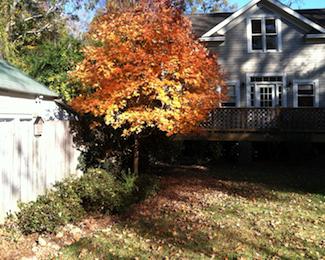Fall Lawn Care - Handling Fall Leaves
By the time autumn rolls around each year, most homeowners are ready to give the lawnmower a rest for the winter months and not have to worry about lawn care for awhile (we're not going to think about all that snow shoveling just yet).
Before we give up our lawn care duties for another season, there is one final chore we need to deal with; leaves. After the trees have put on their colorful fall display, they drop their leaves, selfishly leaving quite a mess for us to clean up.
Food For Your Landscape
In nature, a tree's leaves act like vitamins. Leaves on the forest floor can provide up to 80% of a tree's nutrients each year. Layers of leaves decomposing also contribute to healthy soil, regulating temperature and moisture levels in the ground. Leaves are a perfect food for trees. During the summer, they capture the sun's energy to help the tree grow; when they fall to the ground they break down into nutrients that feed the tree through its roots.
If your home is in a wooded setting, you can let the leaves fall and leave them. In a suburban setting, however, leaves are a different matter. If you have a lawn, you can't really leave a thick layer of leaves on the ground. They will block the sunlight and kill whatever is underneath; namely, your grass lawn you've worked so hard to keep beautiful all summer long.
Keep 'em From Filling Up Landfills
Many people spend hours raking and bagging leaves from their yard. Each year, approximately 8 million tons of leaves end up in landfills. That's a lot of matter taking up a lot of valuable landfill space. Others rake leaves into piles and burn them. The smell of burning leaves on a cool fall day is a lovely thing, but burning leaves contributes to unhealthy air pollution. Burning is also illegal in many areas.
So, what to do with all these leaves? Rather than throw them away, why not keep them on the lawn and turn them into food for your turf? Think of leaves as free, nutritious food for your lawn.
Mulch Those Leaves!
Most lawnmowers today can mulch what they mow; mulching grass and leaving the clippings on your lawn is a healthy thing to do during the summer months. Mulching leaves in the fall is equally beneficial for your grass, trees, shrubs, and other plants.
If you have a thick layer of leaves on your lawn, it's probably going to be difficult to push a mower through them. Rake up some of the leaves, leaving a thin layer of leaves on the grass. The leaves you rake up can be placed in piles of 3 to 6 inches around trees or shrubs to provide a nourishing layer over the winter.
Raked leaves are also great to put in your compost pile. You do have a compost pile, don't you? If you don't, many municipalities offer community composting.
Invest In A Mulching Blade For Your Mower
For the leaves remaining on the lawn, simply mow over them with your mulching mower. This will chop them into little bits, which will allow them to break down easily into the soil. This will happen over the winter months, and come spring these free vitamins will help your lawn bounce back and be healthy and green.
Don't worry about having a thin layer of mulched leaves on your lawn going into the winter. It won't look like a perfect lawn, but you will be contributing to a lawn that is a natural living habitat. The leaves will break down over the winter and spring until they're gone. Not only will your grass and plants love it, but so will the animals and critters that live there.
If you or your kids love to jump in piles of leaves (a fall tradition around here!), you can always rake and jump first, and mulch later.
comments powered by Disqus



































































